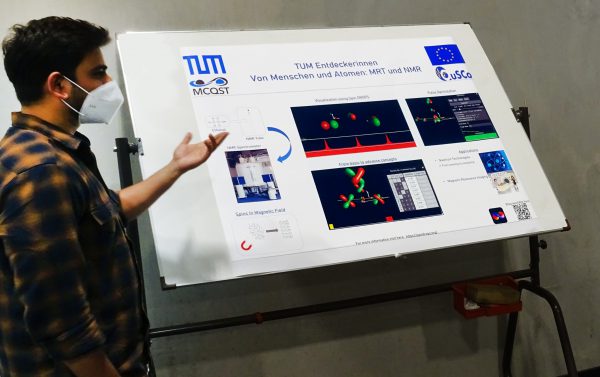Prize winning quantum outreach
In June, QuSCo Ph.D. student Amit Devra participated in a challenge at the Munich Conference on Quantum Science and Technology 2020 (MCQST) where they were to make an interactive poster to be presented in a virtual 3D environment. On top of the awards for the best posters, the one gaining most likes when tweeting about the poster would also win a prize.
Amit Devra was the one with the most likes on his tweet and he won 500 euros to finance participation at a conference or a visit to a research group. We have asked him some questions about his experience with outreach and what it means to him.
If you don’t know what QuSCo is, we have a blog post about it that you can read here.
The importance of outreach
Amit finds outreach an interesting and important part of science. It gives you insights and an opportunity to connect with people by explaining your research and provides you with a deeper understanding of your field. Using social media, such as Twitter, is a way to reach out to people interested in science who you may otherwise not reach. Posters were presented in virtual conference rooms as the conference was online due to the COVID-19 pandemic. This offered a great opportunity to use social media for outreach and Amit exploited this opportunity, tweeted about this poster and won by having the most likes. His virtual poster included videos where Amit used the SpinDrops tool to communicate his research. The small video clips were put together with text and explanations.
Watch one of the videos here:
Visualization of operators by Amit Devra on ScienceAtHome Vimeo.
Inspiring high school students
Amit also recently participated in the “TUM Entdeckerinnen” which was an event focused on young girls being introduced to the field of STEM (Science, Technology, Engineering, and Mathematics). It was held at the Technical University of Munich during the summer vacation. Together with his colleagues Dominik Diermann and Prof. Steffen Glaser he was working with 12 high school girls who were given an introduction to the science behind MRI and NMR and how this technology has applications from physics to biology and medicine.

Amit shows a poster with an NMR spectrometer depicted on the left and screenshots from SpinDrops in the middle.
The students also explored how to solve small tasks with SpinDrops in a playful way. Amit and his colleagues were available for questions and guidance. Additionally, Amit performed some simple experiments on the spectrometer at the Bavarian NMR center (BNMRZ) to give students an idea of what a spectrum looks like and explained some of the applications of it. Amit says it was a good experience to instruct the students and they also got very good feedback from them. The participating students wished for the event to be longer than two days in the future and they wanted to do experiments of their own. So, Amit felt that the girls left motivated by the event. This was probably related to the use of concrete tools during the event. Amit says it was really helpful to have some interactive sessions to explain the complicated concepts to the students.
We asked Amit what we need in the future to do more engaging outreach to inspire young students. His answer was:
“To have more events like this. And the use of tools such as SpinDrops and Quantum Composer to explain complicated science in easier terms.”
Outreach training
During the QuSCo outreach training that ScienceAtHome is the lead on, Amit had gained previous experience in breaking down the science into simpler terms, which was helpful for him during the outreach session with high school students.
The outreach training prepares the QuSCo Ph.D. students by giving them different assignments that will help them communicate their research to a wider audience. These workshops are carried out by the ScienceAtHome team. Until now, the students have been instructed to write a blog post explaining the what, why, and how of their research. They were also taught how to make scientific visualizations via infographics to explain their research in images. On top of that, they learned how to create simulations using digital tools like e.g. Quantum Composer or SpinDrops to visualize a quantum mechanical phenomenon.
The outcomes of these workshops were helpful for Amit in an event like the TUM Entdeckerinnen. The high school students were interested in reading his blog post that was accessible via a QR code on his poster.
We want to congratulate Amit on his recent prize and thank him for taking the time to talk to us. We are excited to see that our training is helping the QuSCo Ph.D. students realize the importance of outreach in practice and that they put it to good use.
Read more about Ph.D. student Amit Devra on the QuSCo website.

